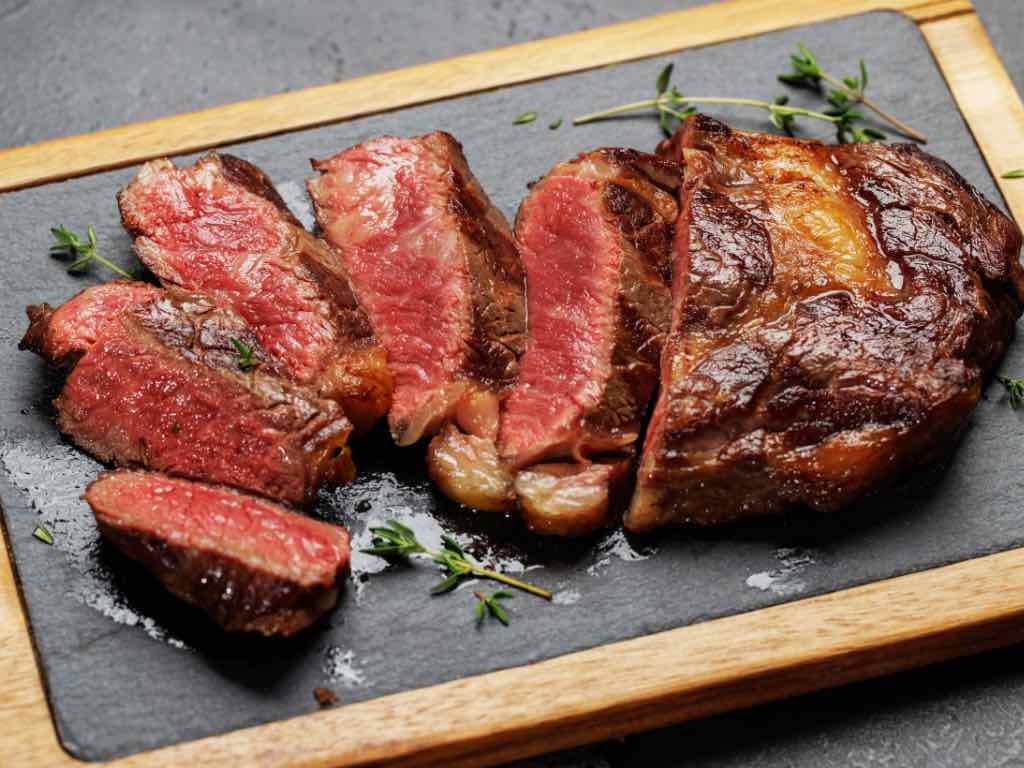
The Ultimate Guide to Dry Aged Ribeye: Flavor and Cooking
|
|
Time to read 4 min
Welcome to One Stop Halal!
Written by: Najma A.
|
|
Time to read 4 min
Dry aged ribeye is a culinary masterpiece, a testament to the patience, skill, and dedication that transforms a simple cut of beef into a flavorful, tender, and luxurious dining experience. This blog will delve into the intricacies of dry aging, the science behind the process, the unique characteristics of dry-aged ribeye, and tips for preparing and enjoying this delicacy at home.
Dry aging is a controlled process where beef is stored in a specific environment to enhance its flavor and tenderness. Unlike wet aging, where beef is vacuum-sealed and stored in juices, dry aging involves hanging the meat in a relaxed, humidity-controlled environment for several weeks. This process allows the natural enzymes in the beef to break down muscle tissue, resulting in a more tender texture and a concentrated, robust flavor profile.
The science of dry aging revolves around two primary processes: enzymatic breakdown and moisture evaporation.
Creating the perfect environment for dry aging is crucial. The ideal conditions include:
Maintaining a consistent temperature between 34°F and 38°F (1°C to 3°C) is essential to slow bacterial growth and enzymatic activity.
A relative humidity of around 80% helps to prevent excessive drying and crust formation on the beef’s surface.
Proper ventilation ensures that air circulates evenly around the meat, preventing spoilage and promoting uniform aging.
The process starts with selecting high-quality beef, often prime or choice grades with substantial marbling. Due to its marbling and fat content, Ribeye is an ideal candidate for dry aging.
The beef is trimmed to remove excess fat and placed on racks or hung in a designated aging chamber.
The beef is left to age for a period ranging from a few weeks to several months. Standard aging periods are 28, 45, and 60 days, each offering different flavor intensity and tenderness levels.
During the aging process, the beef is regularly inspected to ensure no spoilage. Any undesirable mold growth is trimmed away.
Once the desired aging period is reached, the outer crust formed on the beef is trimmed off, revealing the rich, marbled meat underneath.
Dry aged ribeye steak is distinguished by its unique characteristics:
The flavor of dry aged ribeye is more intense and complex. It often exhibits nutty, earthy, and slightly sweet undertones, with a distinct umami taste that enhances the beef’s natural flavor.
The enzymatic breakdown of muscle fibers results in a significantly more tender texture, making each bite melt in your mouth.
The aroma of dry aged beef is richer and more pronounced. Due to the concentration of flavors and the aging process, it is often described as having a slightly musky, blue cheese-like scent.
The meat’s color may darken slightly during aging, and the marbling (fat within the muscle) becomes more pronounced.
Cooking a dry aged ribeye recipe requires some care to preserve and highlight the unique flavors and textures.
Remove the ribeye from the refrigerator and let it come to room temperature before cooking. This ensures even cooking and better flavor development. Season the ribeye simply with salt and pepper. The robust flavors from the dry aging process do not require heavy seasoning.
Dry aged ribeye is best cooked using high-heat methods such as grilling, broiling, or pan-searing to develop a flavorful crust while keeping the inside juicy and tender.
Aim for a medium-rare to medium doneness to enjoy the full flavors. Use a meat thermometer to ensure precise cooking: 130°F to 135°F (54°C to 57°C) for medium-rare.
After cooking, let the ribeye rest for about 5-10 minutes. This allows the juices to redistribute throughout the meat, ensuring a moist and flavorful steak.
Pairing and serving dry-aged ribeye can enhance the dining experience.
Classic steakhouse sides like creamy mashed potatoes, sautéed mushrooms, and roasted vegetables are excellent accompaniments. These sides provide complementary textures and flavors without overpowering the steak.
While dry aged prime ribeye is flavorful, a simple sauce such as a chimichurri can add a delightful contrast and additional layers of flavor.
Dry aging ribeye at home is possible for those interested in the ultimate culinary adventure, but it requires careful attention to detail.
A dedicated dry-aging or modified standard refrigerator with a humidity controller and fan can create the necessary environment.
Choose high-quality ribeye cuts, and ensure they are properly trimmed and prepared. It’s best to start with whole subprime cuts like ribeye roasts rather than individual steaks.
Regularly check the temperature, humidity, and airflow in the aging chamber. Inspect the meat for signs of spoilage and trim away mold growth.
Dry aging requires patience. Start with a shorter aging period, like 28 days, and experiment with more extended periods as you become more comfortable with the process.
Welcome to Home of the Halal Wagyu. We carry various Wagyu meat cuts that are hard to find elsewhere. We deliver to your doorstep anywhere in the United States within 1-2 business days.
Dry aged ribeye is a testament to the beauty of patience and the art of culinary craftsmanship. Its rich, complex flavors and tender texture make it a standout choice for special occasions or when you want to indulge in a superior steak experience. Whether enjoyed at a high-end steakhouse or crafted at home, dry aged ribeye offers a memorable and luxurious taste journey that is well worth the wait. So, the next time you want to elevate your dining experience, consider the sublime pleasure of a perfectly dry aged ribeye – a true celebration of beef at its finest.

© 2025 One Stop Halal, Inc.